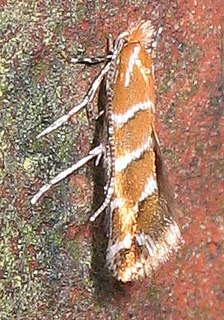
The horse-chestnut leaf miner is a leaf-mining moth of the family Gracillariidae. The horse-chestnut leaf miner was first observed in North Macedonia in 1984, and was described as a new species in 1986. Its larvae are leaf miners on the common horse-chestnut. The horse-chestnut leafminer was first collected and inadvertently pressed in herbarium sheets by the botanist Theodor von Heldreich in central Greece in 1879.

Phthorimaea operculella, also known as the potato tuber moth or tobacco splitworm, is a moth of the family Gelechiidae. It is an oligophagous insect that feeds on the plant family Solanaceae and is especially known for being a major pest of potato crops. Currently farmers utilize insecticides, parasites, and sprinkler irrigation in order to prevent P. operculella from infesting their croplands.

Birch leafminers are sawflies, which are closely related to bees and wasps. They are among the most common insect pests affecting Birch trees in North America. Areas inside the leaves are consumed by the larvae, affecting the leaves' ability to produce food. Yearly browning of birch leaves are noticed in mid July and August, but the leafminers have been feeding inside the leaf tissue since early spring.

Eriocrania sparrmannella also known as the mottled purple is a moth of the family Eriocraniidae, found in Europe and Japan. It was first described by the French entomologist, Louis Augustin Guillaume Bosc in 1791. The specific name honours the Swedish naturalist Anders Erikson Sparrman. The larvae mine the leaves of birch.
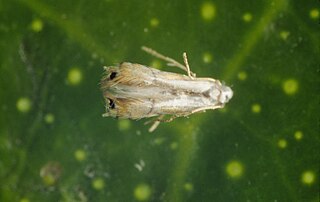
The citrus leafminer is a moth of the family Gracillariidae. It is also known as CLM in agriculture. It was first found in Florida in 1993, but is now found all over the world, including Argentina, Australia, Brazil, China, Corsica, Costa Rica, Cuba, India, Israel, Madeira, Malaysia, Mauritius, Mexico, the Philippines, South Africa, Spain, Sri Lanka and other parts of the United States.
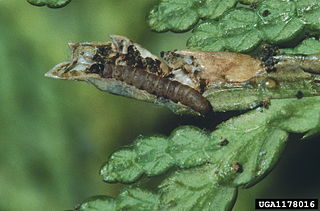
Coleotechnites thujaella is a moth of the family Gelechiidae. It is found in the north-eastern parts of the United States, as well as Canada.
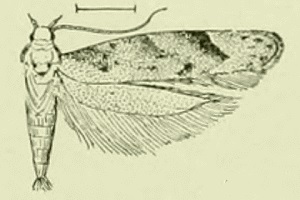
Coleotechnites piceaella is a moth of the family Gelechiidae. It is found in north-eastern United States and Canada. It is an introduced species in Europe and was first recorded from Great Britain in 1952, then Germany in 1963 and has expanded from there over all of central Europe, towards France, Italy and Hungary.

Phyllonorycter roboris is a moth of the family Gracillariidae. It is found in all of Europe.

The spotted tentiform leafminer is a moth of the family Gracillariidae. It is known from all of Europe, east to Ukraine and central Anatolia. It is also known throughout North America including Nova Scotia, Quebec, Ontario, Wisconsin and California.
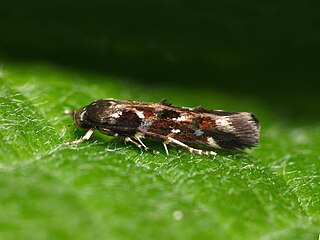
Mompha terminella is a moth in the family Momphidae found in Europe and North America.
Coptodisca cercocarpella, the curl-leaf mountain mahogany leafminer, is a moth of the family Heliozelidae. It was described by Annette Frances Braun in 1925. It is found in North America, including Arizona, California, Utah and Colorado.
Coptodisca kalmiella is a moth of the family Heliozelidae. It was described by Dietz in 1921. It is found in North America, including New Jersey.
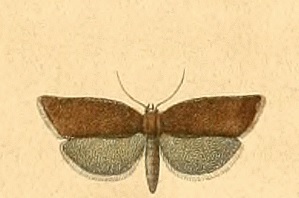
Clepsis unicolorana is a moth of the family Tortricidae. It was described by Philogène Auguste Joseph Duponchel in 1835. It is found in France, Spain, Switzerland and Italy.
Stilbosis ostryaeella, the ironwood leafminer moth, is a moth in the family Cosmopterigidae. It was described by Vactor Tousey Chambers in 1874. It is found in North America, where it has been recorded from Quebec, Ontario, Illinois, Maryland, Maine, Massachusetts, Kentucky, Ohio, Arkansas and Florida.
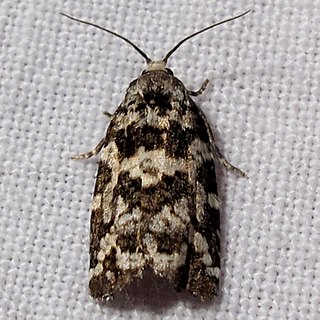
Archips packardianus, the spring spruce needle moth or spruce needleworm, is a species of moth of the family Tortricidae. Spruce needle worms are commonly found in small numbers on spruce and trees of other coniferous genera throughout most of Canada and the northeastern US. Archips packardiana overwinters as a tiny larva in a mined needle. Needle mining is resumed in the spring, the larvae later moving to feed on new foliage, where they spin considerable webbing. Full-grown larvae have a pale green head, sometimes patterned with brown, and a pale body and pale thoracic legs, and are about 20 mm long. The larva pupates, usually in the webbed needles, and the adult emerges in summer to early fall. The closely related Archips strianus is much less common, but probably has a habitat similar to that of A. packardiana. The larvae have dark thoracic legs and small dark areas around the base of the thoracic hairs. The habitat consists of coniferous and mixed woods.

Odontopus calceatus is a species of weevil which occurs in much of the eastern and southeastern United States. Its range is as far north as Massachusetts all the way south to the Gulf of Mexico, and from the Atlantic westward to the Mississippi River. Common names include yellow poplar weevil, sassafras mining weevil, tuliptree leafminer, tulip tree weevil, or the magnolia leaf miner.
Keiferia glochinella, the eggplant leafminer moth, is a moth in the family Gelechiidae. It was described by Zeller in 1873. It is found in the United States, where it has been recorded from Texas, New Mexico and California. Records outside the western United States are based on misidentifications.
Liriomyza sativae, commonly known as the vegetable leaf miner, is a species of insect, a fly in the family Agromyzidae. The larvae of this fly mine the leaves of a range of vegetables and weeds, but seem to favour plants in the families Cucurbitaceae, Fabaceae and Solanaceae.
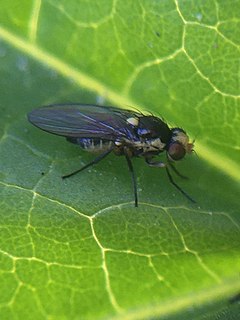
Liriomyza huidobrensis, commonly known as the pea leaf miner, is a species of insect, a fly in the family Agromyzidae. The larvae of this fly mine the leaves and stems of peas and a range of other vegetables. It is also known as the serpentine leaf miner, but this name is also used for a closely related species, Liriomyza brassicae.

Profenusa thomsoni, the amber-marked birch leaf miner, is a species of sawfly in the family Tenthredinidae. It is native to the Palearctic realm but has spread to North America. The larvae feed on the foliage of birch trees.














